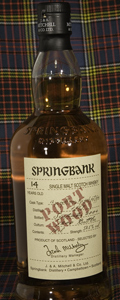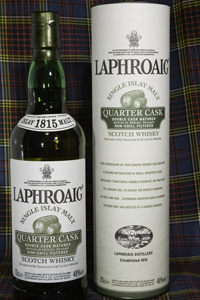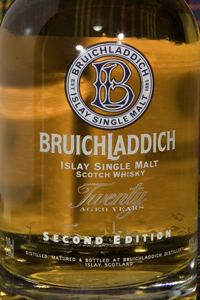

Click here for the PDF version
Wood and finishes
Since the Scotch Whisky Act of 1988, all scotch whiskies have to be matured in oak casks. Traditionally, these casks held previously sherry or, after the Second World War, American bourbon. Maturation is the process of maturing whisky in wooden casks and during this process, chemical reactions occur between the wood and the spirit. The wood will add and remove some flavours to the whisky. Ex-bourbon casks are charred (“burnt”) and will principally release vanillin and lactone extracts (vanilla or coconut aromas), while the sherry casks are toasted (milder treatment) and thus will give more colour and heartwood constituents (1).
Wood finish or wood finishing


After the first maturation in a sherry or bourbon cask, the whisky is transferred in another cask for a period of a few months to several years. The term wood finish is recent and has been marketed in the 1990s by Glenmorangie (eg. Glenmorangie Port wood) and Balvenie (Balvenie DoubleWood). The most commonly used term for wood finishing is “finish”, but other words like “enhanced in” and “mellowed are also used (and how will the consumer make the distinction?). Wood “finishes” existed before the 1990 and it was not unusual for independent bottlers like Gordon and McPhail to transfer the content of one cask owned by the distiller to one cask selected by the bottler. The first maturation will provide to the body to the whisky and the finish will add extra flavours. The finish might last from a few months (e.g., 6 months for the Balvenie Islay Cask) to several years (e.g., 2 years in sherry casks for the Glenmorangie 18 YO or 2 years in a rum cask for the Springbank Rum wood 12 YO).
Glenmorangie and Arran have the highest number of wood finish products as shown in table 1.
|
Table 1: List of some wood finishes |
||
|
Glenmorangie |
Arran |
Other |
|
Claret |
Calvados |
Chenin Blanc |
|
Côte de Beaune |
Champagne |
French oak |
|
Burgundy |
Chateau Margaux |
Islay |
|
Côte de Mersault |
Cognac |
Malmsey |
|
Cotes de Nuit |
Marsala |
Mourvedre |
|
Madeira |
Montepulciano d'Abruzzo |
Petite Arvine |
|
Malaga |
Port |
Red Wine |
|
Port |
Rum |
Scottish oak |
|
Sauternes |
|
Syrah |
|
Sherry |
|
White oak |
|
Cognac |
|
White wine |
|
Tain l'hermitage |
|
|
|
Rioja |
|
|
Also, from this table, we can see that the list of wood finishes can be quite extensive. In addition to the companies cited above, others such as Glenfiddich (e.g. Glenfiddich Havana, Bruichladdich (e.g. 20 YO second edition “flirtation”), Bowmore (Bowmore Dawn) and the Glenlivet (e.g. the Glenlivet French Oak) followed this trend. Even Bunnahabhain has released a port wood finish last year and the Isle of Jura is testing a finish in French oak!

The distillers were the first to promote their wood finishes. Independent bottlers such as Gordon and McPhail (e.g. Private Collection Imperial 1990 Calvados Finish) or Douglas Laing (e.g., Old Malt Cask Glen Grant 1992 Wine Finished) then followed.
Some companies such as Auchentoshan might use up to three different casks for their maturation and finish: 1 American cask and 2 different sherry casks (Oloroso and Pedro Ximenez) for the Auchentoshan three wood.
For young ones only?
There is no age for wood finishes. Some distilleries do propose wood finishes with very young whiskies (e.g., 6-8 years old Arran) and some with much older expressions (e.g., Glenmorangie 30 years old Malaga cask). Douglas Laing proposes a 37 years old Caperdonich Rum finished whisky. In fact, as it was matured in different casks, from American oak casks to Gonzales Byass Spanish sherry casks, the famous Dalmore 62 Years old can be considered as the oldest existing wood finished whisky.
And why wood finish?
As mentioned above, ex-bourbon or sherry casks play an important role in the development of the whisky and its flavour. Each cask type will contribute differently to the whisky. Casks, which held previously rum, port, wine or other spirits, would not be suitable for maturation. The reason are that previous liquids will impact too much on the whisky or because the influence of the previous liquid would be destroyed by toasting or charring, or else because the availability (and cost) of those cask is too limited.
With wood finish, in addition to the contribution of the maturation cask, you can “enhance” matured whisky with additional notes characteristic for the “finishing” cask, like sweet and “winey” notes from wine casks or exotic fruits from rum casks.
The difference between a wood finish malt and a “normal” malt
Wood finish has an impact on the aromas of your single malt. Depending on the length of the finish, the initial characteristics of the spirit and the cask type used for the maturation and for the finish, the results might vary considerably. The quality of the finish or the result is mainly subjective. It is a matter of taste and sometimes a matter of love and hate. I do find most of the sherry or other oak finishes quite satisfactory, as well as some rum finishes. On the other hands, I am less satisfied with Calvados and Port finishes. For me, a wood finish is positive then it adds flavours to the whisky and when this enhancement does respect the original character of the whisky. On the other hand, when the finish dominates the malt or changes its characteristics, like in the Arran Calvados finish, which is less satisfactory.
Conclusion:
The trend in wood finishes is still ongoing and the different actors on the whisky will continue to explore new finishes. The industry is still in its infancy when it comes to wood finish. Financial and marketing considerations are still major factors for this trend. This can help a company to show its innovative spirit and for companies with limited numbers of malts or stocks of aged spirit, this might increase the number of product on the shelf. Once the effects of wood finish is better understood and the consumer has made his/her choice, the number of wood finish will narrow and will be an integral part of the malt whisky business.
The future and the consumer will decide.
Slainte!
Patrick
PS: Since the Scotch Whisky Association is now dealing with the definition of whisky (single malt, vatted malts and blends), they could also start to work about the definition of finish and maturation. Soon the average consumer will be completely lost about the whisky terminology.
1. I. Russell, Whisky : technology, production and marketing : handbook of alcoholic beverages series (Academic, London, 2003), pp. xvi, 366 p.
P.Brossard/www.whisky-news.com © Jan. 2006